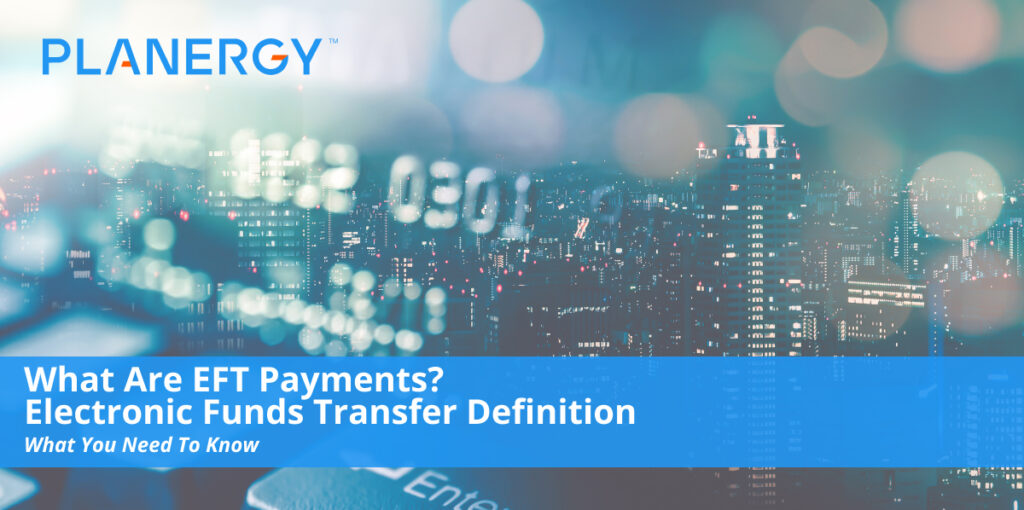Over the course of business, you’ll make plenty of payments. You’ll pay employees for their work, vendors, and suppliers for products and services rendered, etc. Having to sit down to write checks to pay all your bills, then send them for authorization and signing is a time-consuming and outdated process. Thanks to electronic payments, also known as electronic funds transfer or EFT payments, you can skip the check-writing process altogether.
This technology makes it possible to send and receive payments digitally, so you can avoid paper checks and trips to the bank. If you’ve ever paid a bill over the phone, made direct payments from your bank account, or sent and received money from friends or family with a service like PayPal or Zelle, you’re already familiar with EFT.
Let’s take a closer looker at what EFT is and how you can use it to streamline your payments process.
What is Electronic Funds Transfer?
An EFT transaction moves money from one account (the sender or payer) into another (the receiver or payee). This payment method requires both parties to have bank accounts. The good news is that these bank accounts can be at two different financial institutions. It’s possible to make EFT payments using a computer, card readers, or over the phone.
EFTs debit (remove the money from one party’s account) and credit (add the money to another person’s account. The entire process is paperless – so instead of paper checks, you’re writing and cashing electronic checks, also known as echecks.
The Electronic Fund Transfer Act (EFTA) regulates EFTs. The EFTA is a federal law protecting the people who make EFT payments. Under the law, financial institutions must give customers a summary of their rights and notify them of unauthorized transactions.
Is EFT the Same as ACH?
What’s the difference between an EFT and an ACH (automated clearing house) payment? ACH transfers are a type of electronic funds transfer. But, not all EFTs are ACH transactions.
For instance, wire transfers are not processed via an ACH network so they’re not an ACH payment but are an EFT transaction. EFT is an umbrella term used to describe any transfer of money that occurs electronically.
Types of EFT
There is no shortage of ways to electronically transfer money. Here are some of the most common methods your business may use for EFT transfer.
- Wire Transfers: This is a fast way to send money. A wire transfer is usually reserved for sending large sums of money on an infrequent basis. Why? There’s usually a hefty fee ($20-$30) per wire.
- Direct Deposit: This is the best and easiest way to pay employees. After running payroll, notify the direct deposit service provider of the amount to deposit in each bank account. From there, the service provider transfers the money to each employee’s bank account on payday. Check the laws and regulations in your area because not all employers have the option to make direct deposit mandatory. You must have each employee’s bank account information to process these payments.
- Direct deposits run through an automated clearing house network (ACH network) to transfer the money from your business bank account to your employee’s bank account. Since there is no fee, it’s a cost-effective way to pay your staff.
- Electronic Checks: These are similar to their paper counterparts, but run electronically. You enter the routing number and bank account number from the check to make payment.
- ATMs: These machines let you conduct banking transactions without going inside to visit a teller. It’s easy to deposit funds, withdraw cash, or move funds between your accounts.
- Debit Cards: These cards are attached to your checking account. They allow you to make EFT transactions. You can use the debit card to move money from your business bank account. Using your debit card you can make purchases or pay bills either online, over the phone, or in person. Debit cards also make it possible to
- The Electronic Federal Tax Payment System (EFTPS): This is a tax payment service you can use to make your quarterly and annual tax payments to the IRS.
- Personal Computer Banking: This makes it easy to conduct banking transactions using your computer or another mobile device. You can move money between accounts, send money, or pay bills. This is sometimes referred to as online banking. Many banks offer bill pay services for free, direct from your bank account.
- Mobile Wallets: If you’ve ever used a service like Google Pay, Apple Pay, or Samsung Pay, you’ve used a mobile wallet. These wallets store your payment information and make it easy for you to pay for purchases with your mobile device. Using a mobile wallet, you can pay bills, move money between accounts, or receive payments.
EFT is a fast, secure, and convenient way to send and receive money for business and personal purposes.
How EFT Payments Work
If you want to send or accept EFT payments, there are a few things you need to know.
To make EFT payments, the sender has to know the recipient’s bank account information. If you’re making the payment to someone else, you have to authorize the funds transfer. The money is then taken from your account and sent to the recipient.
Some EFT transactions come with fees. For example, you may have to pay fees for certain ATM transactions, such as using an out-of-network ATM or checking your balance. Other transactions, like sending or receiving a direct deposit may be free.
All EFTs, whether they are an ACH transaction or no, begin with an electronic device. It may be your computer, a point-of-sale device, your mobile phone, an ATM, or your telephone. They may be either one-time payments or recurring payments.
If the EFT operates on the ACH network, it’s processed in batches every day. Banks send each other files of the credit and debit information to adjust balances. The fund transfers are processed by verifying payment details, funds availability, and authorization for the accounts sending and receiving the money. It’s because of this verification process that it can take several days to receive the money.
EFT Payment Processing Time
The amount of time required to process an EFT payment depends on a variety of factors, such as:
- The type of payment
- Your EFT provider
- Where you’re sending money – International payments take longer
- When you submit the payment – payments are only processed on business days. If you submit it on Friday after the cut-off time, it won’t be processed until Monday. Processing time doesn’t include holidays.
Expect your EFT transfer to take one to four days to complete. Some transfers are sent and received on the same day, such as wire transfers. Some, like those through Facebook payments, take place in real-time. This is because those transactions are attached to your debit card instead of your actual bank account.
Is it Possible to Stop EFT Payments?
Typically, after you initiate an EFT payment, you cannot stop it. The EFTA doesn’t give you the right. If you have to stop a payment or need a refund, that’s between you and the person you paid.
That said, you may be able to stop scheduled, recurring payments, such as bill payments. You can stop upcoming payments by notifying your financial institution at least three business days before the next transfer is to occur.
Check with your bank to learn more about their policies regarding stopping scheduled transfers. Otherwise, your stop may not work. Your state may also have additional regulations, so check those laws, too. You may be charged a stop payment fee to cancel a check.
What if Something Goes Wrong with an EFT Payment?
Even though there are laws in place to protect consumers using EFT payments, there may still be a time when you run into an issue. Your vendor payment could be sent to the wrong account, the deposit may not come as expected, or your information could be used in a fraudulent transaction.
This is why you should always monitor your accounts to check for any strange activity. Contact your financial institution if you notice anything out of the ordinary.
Keep track of transaction details like the time, date, payee, and payment method. This information is useful when it comes to research. Communicate the information in writing and follow up until the issue is resolved.
EFT is useful for businesses and consumers. Electronic money makes it possible to conduct business from anywhere in the world without having to wait on a check in the mail.




